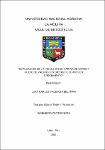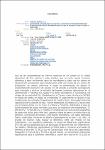Mostrar el registro sencillo del ítem
Evaluación de la inclusión de harina de carne y hueso de vacunos en dieta de cerdos en crecimiento
| dc.contributor.advisor | Vergara Rubin, Víctor Jesús | |
| dc.contributor.author | Valencia Beltrán, Juan Carlos | |
| dc.date.accessioned | 2018-04-30T18:15:25Z | |
| dc.date.available | 2018-04-30T18:15:25Z | |
| dc.date.issued | 2017 | |
| dc.identifier.other | L02-V344-T BAN UNALM | |
| dc.identifier.uri | https://hdl.handle.net/20.500.12996/3255 | |
| dc.description | Universidad Nacional Agraria La Molina. Facultad de Zootecnia. Departamento Académico de Nutrición | es_PE |
| dc.description.abstract | Una de las características de interés comercial en los cerdos es su hábito alimenticio de tipo omnívoro, esto significa que el cerdo puede consumir alimentos a base de diversos tipos de ingredientes y dado que los costos de alimentación representan aproximadamente el 80 por ciento de los costos de producción; es preciso minimizar el costo de alimentación sin afectar el comportamiento productivo del animal. En tal sentido la presente investigación está orientada a evaluar la inclusión de fuentes proteicas alternativas en la alimentación. El objetivo fue evaluar tres dietas isoproteicas e isocalóricas con niveles de inclusión de 0, 5 y 8 % de Harina de Carne y Hueso de Vacuno (HCHV) en dietas de cerdos en etapa de crecimiento. El experimento se realizó en las instalaciones de la Unidad Experimental de Cerdos de la Universidad Nacional Agraria la Molina durante 30 dias. Fueron empleados 36 cerdos de 32 kg de peso vivo promedio de los cruces Duroc, Landrace y Yorkshire, distribuidos al azar en nueve corrales de cuatro animales cada uno, se evaluaron tres tratamientos: T1 (0% HCHV), T2 (5% HCHV) y T3 (8% HCHV) medidos a través de los parámetros de peso vivo inicial, peso vivo final, ganancia diaria de peso, consumo diario de alimento, conversión alimentaria y retribución económica. Los datos obtenidos fueron analizados mediante un diseño completamente al azar y se utilizó la prueba de Duncan para evaluar la diferencia entre las medias de los tratamientos. Los resultados obtenidos no muestran diferencias significativas (P>0.05) para la ganancia diaria de peso para ninguno de los tres tratamientos. Se hallaron diferencias significativas (p<0.05) para el consumo acumulado de alimento a favor del T1 (50.29 kg) en comparación a los otros dos tratamientos evaluados (T2=43.66 kg y T3=48.4 kg).Así mismo, se encontraron diferencias significativas para la conversión alimentaria a favor del tratamiento T2 (2.35) en comparación a los otros dos tratamientos evaluados ( T1= 2.41 y T3= 2.73).En cuanto a la retribución económica relativa se observó que el T1 (100 %) obtuvo un mayor valor numérico en comparación a los otros dos tratamientos evaluados ( T2= 90.52% y T3= 70.08 %).Se concluye que la HCHV puede ser incluida hasta en 5 por ciento en dietas de cerdos en la etapa de crecimiento sin afectar el comportamiento productivo. | es_PE |
| dc.description.abstract | One of the characteristics of commercial interest in pigs is their omnivorous eating habits. Pork can consume food based on various types of ingredients and since feed costs account for about 80 percent of production costs, it is necessary to minimize the cost of food without affecting the animal's productive behavior. In this sense, the research is oriented to evaluate the inclusion of alternative protein sources in the pig feed. The objective was three isoprotein and isolic diets with inclusion levels of 0, 5 and 8% Meat Flour and Beef Bone (HCHV) in growing pig diets. The experiment was carried out within the facilities of the Experimental Unit of Pigs of the National Agrarian University la Molina for 30 days. Thirty-six liveweight pigs of the Duroc, Landrace and Yorkshire crosses were randomly distributed in nine pens of four animals each. Three treatments were evaluated: T1 (0% HCHV), T2 (5% HCHV) and T3 (8% HCHV) measured through the parameters of initial live weight, final live weight, daily weight gain, daily feed intake, feed conversion and economic retribution. The data were analyzed in a completely randomized design and were used in the Duncan test to evaluate the difference between the means of the treatments. (P <0.05) for cumulative food consumption in favor of T1 (50.29 kg) compared to the cumulative weight of food (p> 0.05) for the daily weight gain for any of the three treatments. There were significant differences (2.35) compared to the other two treatments evaluated (T2 = 43.66 kg and T3 = 48.4 kg). Significant differences were also found for food conversion in favor of T2 treatment (2,35) (T1 = 2.41 and T3 = 2.73). Regarding the relative economic remuneration, it was observed that T1 (%) obtained a higher numerical value in comparison with the other two treatments evaluated (T2 = 90.52% and T3 = 70.08%) It is concluded that the HCHV can be included up to 5 percent in pig diets in the growth stage without affecting the productive behavior. | en_US |
| dc.description.uri | Tesis | es_PE |
| dc.format | application/pdf | en_US |
| dc.language.iso | spa | es_PE |
| dc.publisher | Universidad Nacional Agraria La Molina | es_PE |
| dc.rights | info:eu-repo/semantics/openAccess | en_US |
| dc.rights.uri | https://creativecommons.org/licenses/by-nc-nd/4.0/ | * |
| dc.source | Universidad Nacional Agraria La Molina | es_PE |
| dc.source | Repositorio institucional - UNALM | es_PE |
| dc.subject | Cerdo | es_PE |
| dc.subject | Harina de carne | es_PE |
| dc.subject | Harina de huesos | es_PE |
| dc.subject | Harina para piensos | es_PE |
| dc.subject | Dieta | es_PE |
| dc.subject | Desempeño animal | es_PE |
| dc.subject | Ganancia de peso | es_PE |
| dc.subject | Evaluación | es_PE |
| dc.subject | Perú | es_PE |
| dc.subject | Harina de carne y huesos de vacuno | es_PE |
| dc.subject | Cerdo en crecimiento | es_PE |
| dc.title | Evaluación de la inclusión de harina de carne y hueso de vacunos en dieta de cerdos en crecimiento | es_PE |
| dc.type | info:eu-repo/semantics/bachelorThesis | en_US |
| thesis.degree.discipline | Nutrición | es_PE |
| thesis.degree.grantor | Universidad Nacional Agraria La Molina. Facultad de Zootecnia | es_PE |
| thesis.degree.name | Ingeniero Zootecnista | es_PE |
| thesis.degree.level | Título Profesional | es_PE |
| dc.subject.ocde | https://purl.org/pe-repo/ocde/ford#4.02.02 | es_PE |
Ficheros en el ítem
Este ítem aparece en la(s) siguiente(s) colección(ones)
-
ZOO-NU Tesis [141]




